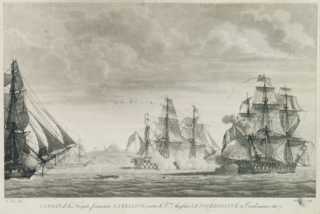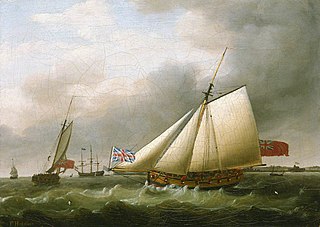HMS Thunderer was a ship of the line of the Royal Navy, built in 1783. She carried 74-guns, being classified as a third rate. During her service she took part in several prominent naval battles of the French Revolutionary Wars and the Napoleonic Wars; including the Glorious First of June, the Battle of Cape Finisterre and the Battle of Trafalgar.

HMS Guadeloupe, was a 28-gun sixth-rate Coventry-class frigate of the Royal Navy. The ship was designed by Sir Thomas Slade, and was initially contracted to be built with the Pembrokeshire shipwright John Williams of Neyland; however he became bankrupt and the Admiralty transferred the order to the Plymouth Naval Dockyard.

The Foudroyant was an 80-gun ship of the line of the French Navy. She was later captured and served in the Royal Navy as the Third Rate HMS Foudroyant.

Bellone was an Iphigénie-class 32-gun frigate of the French Navy on plans by Léon-Michel Guignace. She took part in the American Revolutionary War in the Indian Ocean with the squadron under Suffren, and later in the French Revolutionary Wars. She was present at the Glorious First of June.

Résolue was an Iphigénie-class 32-gun frigate of the French Navy. The British captured her twice, once in November 1791 during peacetime, and again in 1798. The Royal Navy hulked her in 1799 and she was broken up in 1811.
Sixteen ships of the Royal Navy have borne the name HMS Alert, while another was planned:
HMS Antigua has been the name of four ships of the Royal Navy, named after the Caribbean island of Antigua:
HMS Antigua was a French frigate launched in 1779. She became a privateer that the British captured in 1804. She served the Royal Navy as a prison ship from 1804 to 1816, when she was broken up.
HMS Ariel was a 20-gun Sphinx-class sixth-rate post ship of the Royal Navy. The French captured her in 1779, and she served during the American Revolutionary War for them, and later for the Americans, before reverting to French control. Her French crew scuttled Ariel in 1793 to prevent the British from recapturing her.
HMS Hinchinbrook was the French privateer Astrée, which the British captured in 1778 and took into the Royal Navy as a 28-gun sixth-rate frigate. She was Captain Horatio Nelson's second navy command, after the brig HMS Badger, and his first as post-captain. She was wrecked, with no loss of life, in January 1783.
HMS Albemarle was a 28-gun sixth rate frigate of the Royal Navy. She had been built as the French merchantman Ménagère, which the French Navy purchased in 1779. A British squadron captured her in September and she was commissioned into service with the Royal Navy. Amongst her commanders in her short career was Captain Horatio Nelson, who would later win several famous victories over the French. The Navy sold her in 1784. She subsequently became a merchant vessel again. In 1791 she transported convicts to Port Jackson as part of the third fleet. She then sailed to India where she picked up a cargo on behalf of the British East India Company. As she was returning to England a French privateer captured her.
Three ships of the Royal Navy have borne the name HMS Alligator, after the marine reptile, the alligator. A fourth ship was planned but later cancelled:

HMS Crescent was a 28-gun Enterprise-class sixth-rate frigate of the Royal Navy. Crescent was launched in 1779. The French captured her in 1781. She was wrecked in 1786.
HMS Orpheus was a 32–gun fifth rate frigate of the Royal Navy. She was launched in 1780, and served for more than a quarter of a century, before she was wrecked in 1807.
HMS Loyalist was the 14-gun sloop Restoration, which the Royal Navy purchased in North America in 1779. In May 1781 her captain was Morgan Laugharne. Prior to being acquired by the Royal Navy, the ship belonged to the Connecticut State Navy as the Oliver Cromwell.
Orénoque by one account was a French privateer sloop commissioned in French Guiana in 1781. Another account has her as a Dutch merchant vessel purchased into service. If so, she may have been one of the vessels that some British privateers captured during the raid on Essquinbo and Demerara in late February 1781. The French captured her in 1782 when they captured Demerara; they disposed of her in 1784 or so.

HMS Barbuda was commissioned into the Royal Navy in 1780 after having briefly served as an American privateer. Barbuda was one of the two sloops that captured Demerara and Essequibo in 1781, but the French Navy captured her there in 1782 and took her into service as Barboude. The French Navy sold her to private owners in 1786, and she served briefly as a privateer in early 1793 before the French Navy purchased her again and named her Légère. She served them until mid-1796 when the Royal Navy captured her and took her into service as HMS Legere. She was wrecked off the coast of Colombia, without loss of life, in February 1801.

HMS Ceres was an 18-gun sloop launched in 1777 for the British Royal Navy that the French captured in December 1778 off Saint Lucia. The French Navy took her into service as Cérès. The British recaptured her in 1782 and renamed her HMS Raven, only to have the French recapture her again early in 1783. The French returned her name to Cérès, and she then served in the French Navy until sold at Brest in 1791.
The French brig Duc de Chartres was built between 1779 and 1780 at Le Havre as a 24-gun privateer. As a privateer she captured one British warship before in 1781 the Royal Navy captured her. The Royal Navy took her into service as HMS Duc de Chartres. She then captured several American privateers and armed merchant vessels, and one French naval corvette in a noteworthy single-ship action. The Navy sold Duc de Chartres in 1784.

HMS Fly was a cutter that the Royal Navy purchased in 1778. The French Navy captured Fly in June 1781.








